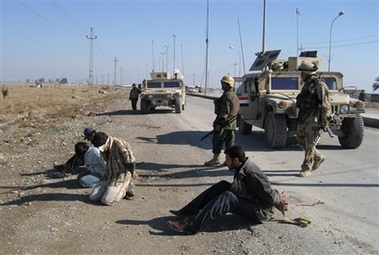Latest Bloodshed
US, Iraqi troops kill 30 militants
(AP)
Updated: 2007-01-25 13:45
 |
Large Medium Small |
BAGHDAD, Iraq - US and Iraqi troops battled Sunni insurgents hiding in high-rise buildings on Haifa Street in the heart of Baghdad Wednesday, with snipers on roofs taking aim at gunmen in open windows as Apache attack helicopters hovered overhead.
 Blindfolded people are detained at the side of the road after an Iraqi army patrol came under attack in Baqouba, 60 kilometers northeast of Baghdad, Iraq, Wednesday Jan. 24 2007. [AP]  |
New details also emerged about the downing of a private US security company helicopter on Tuesday, with US and Iraqi officials saying four of five Americans who died in the incident were shot execution-style. Violence was unrelenting in Iraq on Wednesday, with at least 69 people killed or found dead, including 33 tortured bodies found in separate locations in Baghdad.
With President Bush pushing a controversial plan to increase troops strength in Iraq, government spokesman Ali al-Dabbagh said the latest joint raid was aimed at clearing the Haifa Street area of "terrorists and outlaws" targeting residents. He promised such operations would continue as US and Iraqi troops prepare for a broader security crackdown to stanch the sectarian bloodletting that has turned Baghdad into a battlefield.
At 5 a.m. Wednesday, Iraqi army and American troops moved into the Sunni stronghold to launch targeted raids in a third bid this month to clear the neighborhood of militants. Armored vehicles massed along Haifa Street, where a median with trees separates four lanes of traffic lined by tall apartment houses built by Saddam Hussein for loyalists and dissidents from other Arab countries, mainly Syria.
The US-Iraqi force faced fierce resistance from insurgents using hand-grenades, rocket-propelled grenades and small arms from the high-rises, the American military said. The explosions were so loud they could be heard across the capital. Black smoke rose from the area, located on the west bank of the Tigris River about a mile north of the Green Zone, site of the US and British embassies as well as the Iraqi government headquarters.
At one point, US and Iraqi forces rushed into an office building on the edge of Haifa Street and told all the employees to go home as they fanned out and sent snipers to the roof, according to Jabbar al-Mashhadani, a Cultural Ministry spokesman.
The US military said the combined force in the operation, dubbed Tomahawk Strike II, detained seven suspected insurgents and seized heavy weapons, including many rocket-propelled grenades, anti-tank rounds and 155 mm artillery rounds. The Iraqi Defense Ministry said 30 insurgents were killed and 27 captured, including four Egyptians and a Sudanese.
At least one civilian was killed and seven were wounded, hospital and police officials said.
The military reported separately that an American soldier was killed Wednesday in clashes near the city's center, but officials declined to give more specifics or say whether the death was connected to the Haifa Street fighting. Two US Marines also were reported killed on Tuesday during combat in Anbar province, the military said.
Haifa Street, a major avenue in central Baghdad, was built in the late 1970s and cuts through the neighborhood where Saddam attended school as a teenager and where he once lived with his maternal uncle and future father-in-law.
It has been the site of repeated clashes, including a major battle Jan. 9, just three days after Prime Minister Nouri al-Maliki announced his new security plan for pacifying Baghdad. Fighting broke out again about a week later.
A bronze statue of Iraq's late King Faisal on horseback sits at one end of the broad avenue. During a visit to the neighborhood after the 1991 Gulf war, residents complained to Saddam about their poverty, prompting him to order homes demolished and new apartment complexes built.
Just off Haifa Street is a square where a large statue for Saddam's cousin and brother-in-law, Adnan Khairallah, still stands. It was widely believed that Saddam was behind Khairallah's death in a helicopter crash in 1989 because the defense minister was becoming too popular.
US Ambassador Zalmay Khalilzad, meanwhile, offered condolences for the five Americans killed in the helicopter crash in Baghdad, called them good men and said he had traveled with them. The aircraft, belonging to the Blackwater USA security company, went down as it flew over a dangerous Sunni neighborhood while a gunfight was raging.
| 分享按钮 |